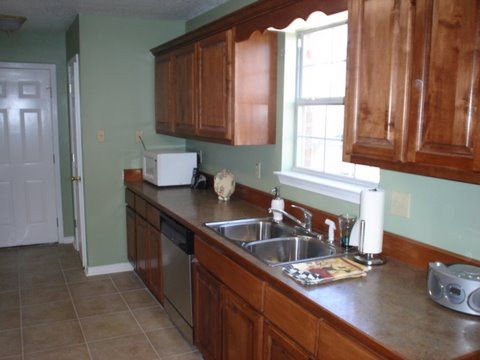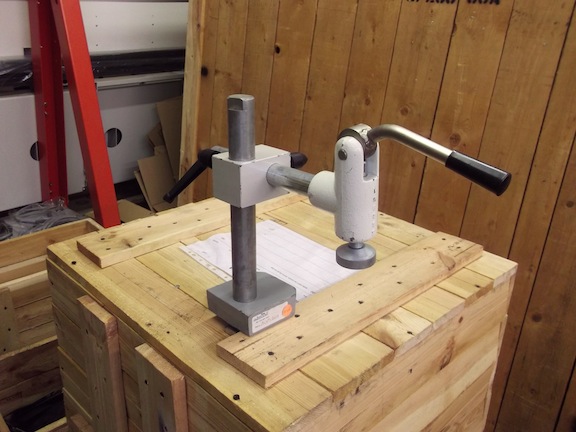Question
When cabinet refacing, what do you use for face frames? Veneer PSA or glue, plywood, or solid wood - 1/4" or 1/8"? I'm trying to put together a bid and want to be able to offer two types of refacing. At the same time I want this to be a top shelf job; looking for nice crisp edges.
Forum Responses
(Cabinetmaking Forum)
From contributor J:
I use WoodOverWood on the rare occasions when I do refacing. It's a two ply product almost like real thin plywood. I work it just like high pressure laminate; spray adhesive, trim with laminate trimmer, etc. The one difference is that laminate rollers don't give you enough pressure to stick the WOW to the frames. They sell little tools that look like putty knives that are for applying it. We finish WOW in the shop and cut it with a hand-held laminate slitter. Have you done any refacing before?
In the old days, I used 1/8" thick door skins and mitered the edges at finish ends, but now I use 10 mil paper-backed veneer. I contact cement the back of the veneer and stick it down on 1/8" masonite without putting contact on the masonite. I prefinish the veneer in a whole sheet, then cut the masonite/veneer into strips on a table saw to match the widths needed to cover the cabinet face pieces. On the job, I just have to pull off the veneer from the masonite and cut it to length on a paper cutter before sticking it to the cabinets. You can also cut the masonite with the veneer still attached on a miter saw, and then remove the veneer.
I have not done refacing before. A customer has asked me to do this for them and I thought it would be a good thing for future business. I will be making new doors and drawers. I had better luck with the PSA veneer in the past.
I'm going to be honest with you. You can make money rafacing cabinets, but it's a lot of work. Often times more than building new cabinets. In our area, I need to get about 2/3 the price of a new set of cabinets to make a profit. From the customer's point of view, I'm not sure that's always a good investment, but I'm always up front with them about that.
There are areas of labor that I severely underestimated when I started doing this. Prepping the cabinets, for one. Removal of the old components is pretty straightforward, but took more time than I thought. Sanding the frames took about three times as long as I had planned. If you don't have some way to capture that dust, such as a Festool or Fein rig, you may want to invest in one. Those frames really need to be sanded and you can imagine the mess the dust would otherwise make. Another factor that's definitely weighable is that most of your work is done in the customer's home. If they don't want to change the tops, I pass on the job. I'm too old and fat to crawl inside cabinets to change all those drawer slides.
One thing you'll need to get up to speed on quickly is evaluating a set of cabinets to see if they're good candidates to reface. Many times they're in too bad of shape. Others are well made but constructed in a way that wouldn't look good refaced. If they look like they will be difficult, rest assured they will be. The first thing I always look for is a scribing ear on the finished ends. That makes the job go a whole lot easier and provides natural transition points and coverage if you put a plywood skin over the ends.
This post sounds sort of negative but I didn't intend for it to be that way. Like I said, you can make a buck at this but I don't want you to get the idea that it's easy money. We maintain the capability to do refacing primarily because nobody else in our area does it. Sometimes any work is good work! When given the choice between that and building new, I go new every time.
What do you mean by a scribing ear? Is this at the wall or the face frame at the front? What I was going to do was trim the face frame even with the side panel, then put a piece of ply on the side even with the front of the face, then cover the front face frame with WOW and trim and sand.
Do you ever bother with the inside of the face frame, where the shelves are?
I was thinking more about factory cabinets with MDF or particleboard components when I was talking about "bad shape." I've seen numerous kitchens where the frames looked pretty good, but the case components were sagging and coming out of their staples.
The scribing ear I was talking about is where the frame extends beyond the finished case side, usually 1/4". If one is there, don't cut or sand it off. It will work for you. Skin the edge of the frame and then the front. Then you can butt plywood up to the back of the scribing ear, creating a clean look. I really don't like the look when you completely cover the side and the frame and WOW meets WOW at the corner of the frame. The cabinet looks like a cube then.
The best solution on a finished end is always to put a raised panel end on the cabinet if you can. If you don't have a scribing ear and raised panel ends aren't in the budget, an alternative is to attach a 1/4" strip of solid wood to the edge of the frame, sand the front flush and skin the front of the frame with WOW. Then there's a place to butt plywood up to the back. It still gives the appearance that there's a transition between plywood and a solid face frame.
By the way, use plywood when and where you can; bottoms and finished end panels for instance. WOW is expensive and not really necessary or as easy to use in those areas.
I always sell refacing as an "external makeover." I always bring up the inside and inside frame edges; I've always told customers, and I believe this to be true, that trying to finish the inside would drive the cost up so much, they'd be far better off to buy new cabinets. I usually change shelves if the old shelves aren't fixed. Also, on the inside edges, taking items in and out of the cabinets will eventually lead to knocking the WOW off. It's better just to leave it.
One suggestion I forgot to offer was to get an old cabinet and reface it. That advice was given to me and was well worth the time and money invested. If you mess up or you want to try a different method, you can peel everything off and reface it again. When you get it looking good, you can show it to customers so they have an idea how the process turns out.
Here are some before/after pictures of the last kitchen we did.
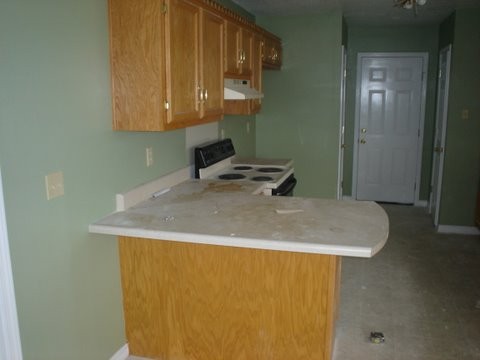
Same cabinets.
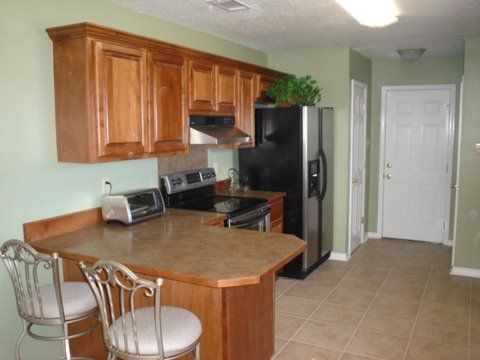
In that last set of photos, that run of wall cabinets over the stove and fridge is all one cabinet.
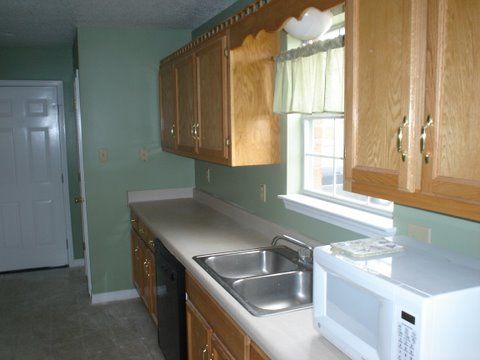
Done.
